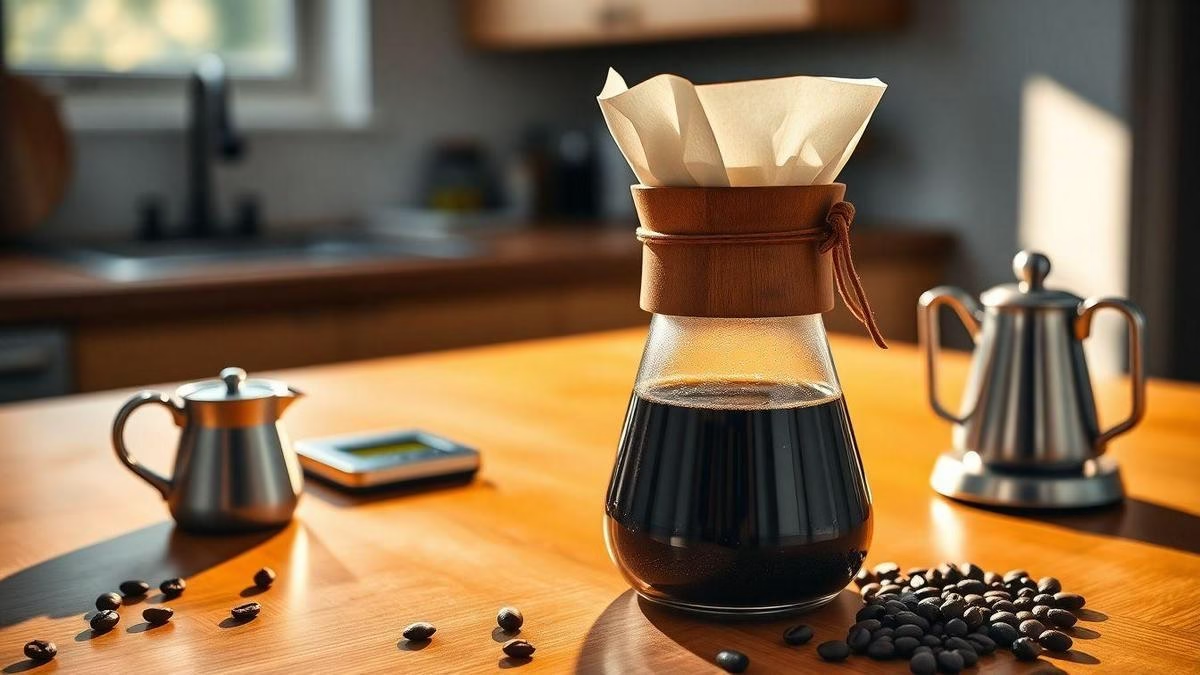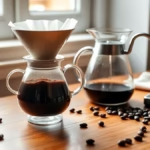Best Tips for Brewing Chemex Coffee at Home
Best Tips for Brewing Chemex Coffee at Home helps you pick the right Chemex size and filters and start with simple, reliable routines. You learn to rinse paper filters and warm the glass to avoid a papery taste. You get the right grind—medium‑coarse like sea salt—and why a burr grinder matters. You control water quality, heat, and timing so your pours and bloom make clean flavor. You follow an easy coffee-to-water ratio, measure by weight, and master steady, circular pours. Finish by rinsing and deep cleaning so your next cup stays pure.
Key Takeaway
- Grind your coffee fresh to a medium-coarse texture
- Heat water just below boiling for balanced flavor (195–205°F / 90–96°C)
- Rinse the paper filter and warm your Chemex before brewing
- Pour in slow, steady circles to wet grounds evenly
- Enjoy your coffee right away for best aroma and taste
Pick the right Chemex size and filters for your brew
Choosing the right Chemex is like picking the right pair of shoes: comfort and fit matter. If you brew for one, the 3-cup Chemex keeps coffee fresh and waste low. For multiple cups, choose 6- or 8-cup models. Size the carafe to what you actually drink—fresh is best. For more detail on the maker itself, see the Chemex coffee maker design and sizes.
Chemex uses thicker paper filters than many brewers, which cut oils and give a clean cup. Use the filters made for your model; they fold differently for each shape and trap different amounts of fines. The right filter plus the right size helps avoid over- or under-extracting and gives a balanced, bright brew.
Quick guide:
| Chemex size | Approx cups (6 oz) | Filter type | Typical coffee grams (1:15 ratio) |
|---|---|---|---|
| 3-cup | 1–2 | Small/3-cup folded | 15–20 g |
| 6-cup | 3–4 | Medium/6-cup folded | 30–40 g |
| 8-cup | 5–6 | Large/8-cup folded | 45–60 g |
Start with simple routines guided by Best Tips for Brewing Chemex Coffee at Home
Start simple and repeat. Measure coffee and water with a kitchen scale. A common starting ratio is 1:15 to 1:17 (coffee to water). For a single cup, 15 g coffee to 225 g water is a solid baseline. Keep variables few: grind size, water temperature, and pour speed. Grind medium-coarse, use water around 195–205°F (90–96°C), and pour in slow concentric circles. Tweak one thing at a time so each change is clear.
Tip: If your coffee tastes sour, try a finer grind or slightly hotter water.
Prepare and rinse paper filters to avoid papery taste (Chemex filter preparation tips)
Rinsing filters is a tiny step that makes a big difference. Fold the filter into the Chemex, pour hot water through it, and let the water drain—this washes away paper fibers and warms the glass. Discard the rinse water, add your grounds, and brew. Rinsing tightens the filter against the glass and helps even extraction, especially with lighter roasts. For practical guidance on filter prep and avoiding paper flavors, check the Guide to brewing and rinsing filters.
Get the right grind: consistency matters for clean taste
Your grind is the single biggest control you have over how clean and bright your Chemex cup will be. Uneven particles produce muddled flavors. For Chemex, aim for a steady flow during brew: too fine brings bitterness, too coarse brings sourness and thinness. Match grind to dose and pour style; small tweaks change the whole cup.
If you follow the Best Tips for Brewing Chemex Coffee at Home, grinding right will save time and headaches. Use a scale and timer, taste as you go, and write down changes so you learn what your grinder and beans prefer. For a step-by-step take on Chemex technique and grind recommendations, see this Step-by-step Chemex brewing and grind guide.
Aim for a medium-coarse grind like coarse sea salt (Chemex grind size and consistency)
Medium-coarse is your target—think coarse sea salt or rough sand. That size keeps the pour steady and extraction even for a thick Chemex filter, pulling sugars and acids at a calm pace so you’ll taste sweet citrus, cocoa, or honey notes instead of bitter or sour extremes.
| Grind name | Look like | Best for | Extraction note |
|---|---|---|---|
| Fine | Table salt | Espresso, Moka | Fast extraction; risk of bitterness |
| Medium | Kosher salt | Drip, Aeropress | Balanced; works for many methods |
| Medium-coarse | Coarse sea salt | Chemex, pour-over | Even, clean taste; steady flow |
| Coarse | Rock salt | French press | Body over clarity |
Use a burr grinder so you get even particles and steady extraction
A burr grinder gives uniform particle size and predictable extraction. Blade grinders chop randomly and create dust and chunks that lead to sour/bitter swings. Burr grinders have settings; pick the medium-coarse area and nudge from there. Clean the burrs occasionally—old oils change flavor fast.
Adjust grind by small steps if your cup tastes sour or bitter
If your cup tastes sour, try a finer grind by one small step—sourness often means under-extraction. If it tastes bitter or hollow, go one small step coarser. Make one small change at a time and brew again; taste and note the difference.
Tip: Make one small change at a time and brew again. Move one notch on the grinder or a couple clicks. Taste and note the change.
Control water: temperature, quality, and timing are critical
Water is half the recipe. Use clear, fresh water so the coffee’s bright, sweet notes come through—hard or chlorinated water can mute flavors. Temperature steers extraction: too cool = weak, too hot = bitter. For Chemex, heat water then let it rest briefly so it sits around 195–205°F (90–96°C). Timing ties the process together: each pour and the total brew time change the final cup. Keep an eye on the clock and your hand steady for a clear, full-bodied Chemex cup. For authoritative guidance on water quality and what to look for when filtering water, see this Drinking water basics and quality guidance.
The first time I dialed my pour and temp, my kitchen smelled like a café. It taught me that small changes make big differences.
Use filtered water and heat to 195–205°F (90–96°C) for best results
Filtered water removes off-flavors and lets the bean speak. If your tap tastes mineral-heavy, use a filter jug. Heat water to 195–205°F (90–96°C). If you don’t have a thermometer, bring water to a boil and wait 20–30 seconds before pouring. A gooseneck kettle helps you pour slowly and evenly.
Quick tip: If your coffee is sour, raise the temp a few degrees. If it’s bitter, lower it slightly.
Time your pours and total brew time to avoid under- or over-extraction
Start with a bloom pour, then add water in slow, controlled pulses. Aim for a total brew time of about 3:30–4:30 minutes for standard recipes (30–40 g coffee to 500–700 g water). If draw-down finishes too fast, grind finer or slow your pours. If it’s dragging, grind coarser or pour a bit faster. Use a gentle spiral motion to wet all the grounds evenly and keep notes: time, grind, pour rhythm.
Start the bloom with a small pour and wait 30–45 seconds before main pours
Begin with about twice the weight of coffee in water for the bloom. Pour slowly to wet all the grounds, then let it breathe for 30–45 seconds to release CO2. For 30 g coffee, bloom with ~60–70 g water.
| Stage | Water temp (°F / °C) | Bloom time | Total brew time |
|---|---|---|---|
| Bloom | 195–205°F / 90–96°C | 30–45 sec | — |
| Main pours | 195–205°F / 90–96°C | — | 3:30–4:30 min |
Use the right coffee-to-water ratio for recipes that work
Getting the ratio right is the fastest route to better coffee. Ratio is parts water to one part coffee by weight. Weigh both coffee and water; grams equal milliliters for water, so the math is easy. Start in the 1:15–1:17 range and taste your way in—lighter roasts and finer grinds often need more coffee; darker roasts may need less.
When you follow the Best Tips for Brewing Chemex Coffee at Home, treat the ratio like a recipe, not a guess. Write down what you try so a great cup today becomes a great cup tomorrow.
Try a 1:15 to 1:17 ratio as a simple starting point
A 1:15 ratio gives a stronger, concentrated brew; 1:17 is lighter and brighter. Use this table to pick amounts for common yields:
| Brew Yield (ml) | 1:15 (coffee g : water g) | 1:16 (coffee g : water g) | 1:17 (coffee g : water g) |
|---|---|---|---|
| 300 ml | 20 g : 300 g | 18.75 g : 300 g | 17.65 g : 300 g |
| 500 ml | 33.3 g : 500 g | 31.25 g : 500 g | 29.4 g : 500 g |
| 700 ml | 46.7 g : 700 g | 43.75 g : 700 g | 41.2 g : 700 g |
Follow a tested Chemex coffee recipe for home and scale by weight
A simple tested recipe: 40 g coffee to 600 g water (1:15). Use medium-coarse grind, bloom with 80–100 g water for 30–45 seconds, then pour slowly in circles until you reach 600 g. Total brew time should sit around 3:30–4:30 minutes. If you want it brighter, move toward 1:16 or 1:17. If weak, bump coffee up a gram or two per 100 g of water. Keep notes: grind, water temp (~94°C / 200°F), and pour rhythm.
Measure beans and water with a scale so you can repeat your favorite cup
Tare the Chemex with filter, add coffee, note the grams, then pour water to the target weight. A scale and timer turn guesswork into repeatable results.
Tip: If a cup is too sharp, try coarser grind or a touch more water; if it’s muddy, go finer or reduce coffee by a gram or two.
Master your pour: bloom, pulse pours, and steady flow
Think of your brew like a conversation: the bloom is the hello, pulse pours coax flavors, and steady flow ties everything together. Practice matters—use the same grind, same water temp, and consistent kettle motion. Small tweaks (more bloom, slower pulse) give big taste differences. With a Chemex, you’re aiming for clarity—keep bloom, pulses, and steady pour in mind.
Bloom first to release CO2 and help even extraction
Bloom for about 30–45 seconds with enough water to wet all grounds (roughly 2x the coffee weight). You’ll see foam rise and fall—CO2 leaving. Skipping bloom lets water chase gas pockets and leaves under-extracted areas.
Tip: If your bloom barely bubbles, your beans might be old. Freshly roasted beans give a lively bloom and better flavor.
Use slow circular pours and avoid pouring on the filter wall
Keep your wrist relaxed and pour in slow circles over the coffee bed—center outward and back. Avoid pouring directly on the filter wall, which causes bypass. Slow pours let water spend the right time with grounds; rushing causes under-extraction, dumping can cause over-extraction.
Keep pours steady so total brew time stays in the 3.5–4.5 minute range
A stable pour speed keeps total brew time in the sweet spot. If brew time falls outside 3.5–4.5 minutes, adjust grind size slightly and try again.
| Stage | Time (approx) | Water added (for 30 g coffee) | Why it matters |
|---|---|---|---|
| Bloom | 30–45 sec | 60–70 g | Releases CO2 for even extraction |
| Pulse pours | 60–90 sec | Add to ~200–250 g | Gently extracts flavor layers |
| Steady finish | Until 3.5–4.5 min | Top up to 450–500 g | Balances acids, sweetness, and body |
Clean, maintain, and follow step-by-step brewing at home
Clean gear, consistent ritual, and attention to small details keep your coffee honest. Wash the carafe and filter area after each brew so oils and tiny grounds don’t build up and change flavor. A tidy workspace and a steady routine—rinse, heat water, grind, pour—make brewing faster and reduce mistakes. For context on coffee preparation and considerations around freshness and serving, see this Coffee health context and brewing notes.
Rinse and wash the carafe after each use to remove oils and grounds
After your last cup, discard the used filter and grounds, rinse the carafe with hot water, and use a soft brush or cloth to remove film. Oils left in the glass make future brews taste flat or stale.
If stubborn spots persist, fill the Chemex with warm water and a drop of mild dish soap, swish gently, and rinse well. Avoid abrasive scrubbers that scratch the glass. Let it air dry upside down.
| Cleaning Task | Frequency | Why it matters |
|---|---|---|
| Rinse and remove grounds | After every brew | Prevents oil buildup and stale flavors |
| Soft wash with mild soap | Daily/every few uses | Removes film without harming glass |
| Weekly deep clean | Once a week | Removes trapped oils and mineral film |
Tip: Rinse your paper filter with hot water before brewing. It removes paper taste and warms the Chemex.
Learn brewing Chemex at home step by step to build a reliable routine
- Boil water and let it cool ~20–30 seconds (target ~200°F / 93–96°C).
- Place a rinsed Chemex paper filter and add freshly ground coffee (medium-coarse).
- Bloom: pour just enough water to wet grounds, wait 30–45 seconds.
- Pulse and finish with slow, steady circles until you reach target water weight.
- Aim for 3.5–4.5 minutes total brew time. Adjust grind/coarseness as needed.
Deep clean weekly with warm water and mild detergent or baking soda
Once a week, remove stubborn oils by filling the Chemex with warm water and a spoonful of baking soda or a drop of mild detergent. Let sit 15–20 minutes, scrub gently, and rinse thoroughly. This keeps mineral films and old oils from muting brightness.
Best Tips for Brewing Chemex Coffee at Home — Quick Checklist
- Use fresh beans and grind just before brewing (medium-coarse).
- Rinse filter and warm the Chemex with hot water.
- Use filtered water heated to 195–205°F (90–96°C).
- Start with 1:15–1:17 ratio and weigh both coffee and water.
- Bloom 30–45 seconds; pour in slow, circular pulses.
- Target total brew time of 3.5–4.5 minutes.
- Rinse carafe after each brew and deep clean weekly.
Conclusion
You’re ready. Keep the basics tight: pick the right Chemex size and filters, use a burr grinder for a medium‑coarse grind, and always rinse the paper to avoid that papery note. Small rituals matter—warm carafe and wet filter are tiny moves with big payoff.
Control your water—filtered and about 195–205°F—time your bloom, and pour in slow, steady circles. Aim for a 1:15–1:17 ratio, measure by scale, and tweak the grind one notch at a time. Little tweaks move the needle; consistency makes the magic repeatable.
Clean gear and a simple routine keep your cup honest. Rinse after each brew, deep clean weekly, and treat your pouring like a short song you can hum. Follow these Best Tips for Brewing Chemex Coffee at Home, and your mornings will taste like a café without leaving your kitchen.
Want more? Read more articles at https://guiabebefeliz.com.

Rafael Souza is a digital marketing specialist and passionate coffee enthusiast. He founded Guiabebefeliz to share practical, easy-to-follow guides for making great coffee at home without needing professional barista skills. His mission is to help readers enjoy better coffee experiences, one cup at a time.






